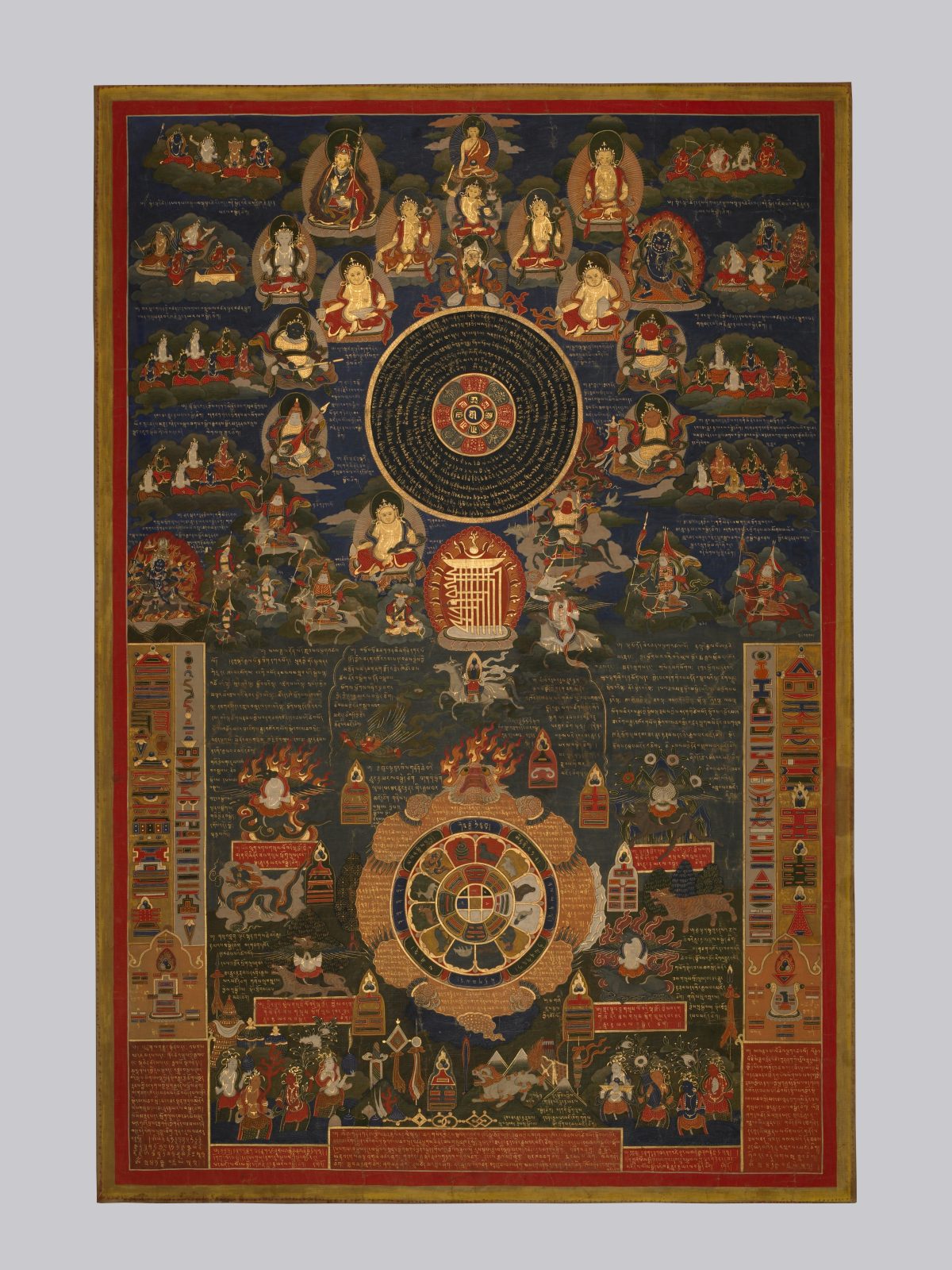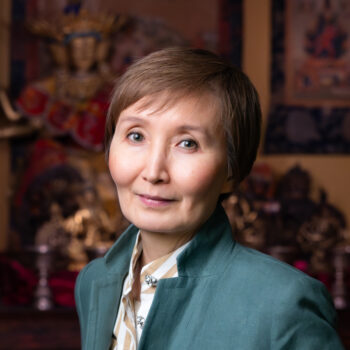
Protective Astrological Chart; Tibet; late 18th or early 19th century; Pigments on cloth; Rubin Museum of Himalayan Art, Gift of Namkha Dorjee/Bodhicitta Art; C2006.71.11

Protective Astrological Chart; Tibet; late 18th or early 19th century; Pigments on cloth; Rubin Museum of Himalayan Art, Gift of Namkha Dorjee/Bodhicitta Art; C2006.71.11
Even before the development of a common written language in Tibet, there existed many stories about the stars, lunar mansions, and the world around us that were passed down through generations. These stories reflect the long history of Tibetans taking an interest in studying, understanding, and decoding the environment and celestial objects. As nomadism and farming are the two most common livelihoods in the region, maintaining a close relationship with nature has been central to existence. The field of Tibetan astro-science—consisting of traditional Tibetan astronomy and elemental astrology—began in tandem with the start of Tibetan civilization.
With the introduction of Buddhism into Tibet, and later with the translation of the Kalachakra Tantra and elemental astrological wisdom from India and China, the development of Tibetan astro-science not only took a great leap but also found its ground in Buddhism. The Vimalaprabha, the principal commentary on the Kalachakra Tantra, beautifully presents how the effects of planets, lunar mansions, and other aspects function to benefit those who perform virtuous actions. From my forty years of experience studying and practicing in this field, one thing I have come to understand is that Tibetan astro-science was originally presented primarily as a means to help against sicknesses and adversaries that disrupt religious practices leading to the ultimate goal of enlightenment.
One practice that has continued over the last eight hundred years is the publication of the almanac. The development of the almanac has corresponded with practical usage by those living nomadic and farming lifestyles. Along with the positions of celestial objects, the annual almanac provides information regarding the change of seasons, precipitation, cycles of flora and fauna, and favorable days to begin farming. The almanac also includes the seasonal cycle of the bodily channels.
Over the course of centuries many great masters have influenced the development of the almanac, with the most recent and transformative changes happening in the early twentieth century. Owing to these progressive contributions, the almanac is now presented as a tool to understand the world around us more holistically. It reflects the interconnectedness between the external world and the internal, both on macroscopic and microscopic levels. In the language of Kalachakra, it is stated, “As is the outside, so is the body. As is the body, so is the other.”
The subject of the five elements—encompassing earth, water, air, fire, and space—is discussed heavily in much Tibetan literature. According to Tibetan astro-science, everything is a product of five elements. An understanding of five elements thus holds the key to the study and practice of this discipline. Be it the formation of the universe, present-day existence, or the eventual disintegration or destruction of the universe itself, everything is seen in the context of the balance and imbalance of these elements. Understanding the natural environment, which has greatly contributed to almanac-making, is after all, an understanding of the five elements.
Birth charts are also commonly linked with astro-science. In the Tibetan custom, parents cast a birth chart for their newborn. Astrologers also create marital compatibility charts, medical charts, charts for the deceased, and others. All the charts are based on the celestial positions and astrological functions, which are all understood in the context of the five elements. The Buddha introduced birth, aging, sickness, and death as the four inevitable sufferings, and I sometimes find the marital compatibility chart, birth chart, medical chart, and chart for the deceased can be helpful in alleviating those sufferings.
As parents’ health and happiness are crucial to the well-being of a newborn, the Tibetan custom of casting a marital compatibility chart provides help in not only bridging understanding between the couple but also in having a more easeful birth.
As we age, a birth chart acts as a tool to better understand oneself. This chart is not fixed but rather a work in progress. It introduces an individual’s capabilities, opportunities, and possibilities, including their strengths and weaknesses, based on their birth details. As in Buddhism, I believe that karmic collection from past lives results in an individual being born to a particular set of parents at a particular time and place.
Medical charts have been increasingly helpful with modern-day health complications and worries. Though such charts were traditionally and more commonly consulted during terminal or chronic illnesses, nowadays people use them on a broader scale. Modern-day lifestyles and challenges have resulted in health conditions where the antidotes advised in the medical charts can be of great benefit along with medications.
The chart for the deceased was originally confined to the Tibetan Buddhist populace. Now with a wider group of people engaged in Tibetan Buddhist practices this type of chart is also finding new grounds. As death is inevitable and the suffering it brings can be overwhelming, the chart for the deceased not only provides help for the deceased in achieving a better rebirth but also offers solace for the remaining family members coping with their loss.
The almanac and these four charts are examples of the means through which Tibetan astro-science provides services to humankind. With everything being a product of five elements, astrologers work to help balance these elements by employing an understanding of celestial objects and other functions of astrology. Standing true to Buddhist philosophy and ideology, Tibetan astro-science draws on the law of causality and the science of interconnectedness.
Protective Astrological Chart; Tibet; late 18th or early 19th century; pigments on cloth; Rubin Museum of Himalayan Art; gift of Namkha Dorjee/Bodhicitta Art; C2006.71.11

Tsering Choezom was born in exile in India. She studied Tibetan astro-science at the Tibetan Medical and Astrological College in Dharamsala. Tsering is the first Tibetan female astro-science practitioner in exile. She has been in the field for forty years and is the head of the Astro-Science Department at Tibetan Medical and Astro Institute, headquartered in Dharamsala. From her first foreign visit in 1995, she has traveled extensively to promote and serve others with her astro-science wisdom.

Elena Pakhoutova is senior curator, Himalayan art, at the Rubin Museum of Himalayan Art and holds a PhD in Asian art history from the University of Virginia. She has curated several exhibitions at the Rubin, including Death Is Not the End (2023), The Power of Intention: Reinventing the (Prayer) Wheel (2019), and The Second Buddha: Master of Time (2018). More →
Get the latest news and stories from the Rubin, plus occasional information on how to support our work.